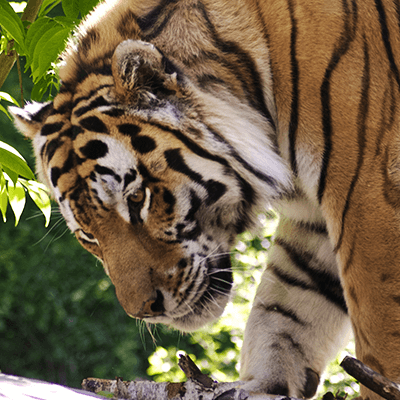
About Amur Tiger
Amur tigers love the cold! They have adapted to tolerate temperatures that fall far below zero. They are also excellent athletes and can leap up to 33 feet. Sadly, Amur tigers are critically endangered — there are fewer than 500 left in the wild.
The Henry Vilas Zoo has joined forces with the Tiger Conservation Campaign to raise funds and awareness to help save wild tigers from extinction. Learn more about the project here.
Habitat
They live in the far east region of Russia in the boreal forest (taiga), and in northern evergreen forests where there are bogs, marshes, and shallow wetlands.
Diet
Amur tigers have a carnivorous, meat-eating diet, consisting mostly of large animals such as elk, deer, and pigs. One tiger will eat 20 – 60 pounds (9 – 27 kg) of meat in one meal.
Family Life
After 3 – 3.5 months, a female will give birth to 2 – 6 cubs (the average is 2 – 3 cubs). The female cares for the cubs by herself. After three months, the cubs begin to accompany their mother on hunts. At 18 months old, the cubs are capable of hunting for themselves, though they don’t leave their mother until they’re 2 – 3 years old.
Conservation Status
The conservation status of the Amur Tiger's conservation status is classified as endangered.
Threats
- Habitat loss due to logging, agriculture, urban (city) expansion, and road construction.
- Poaching for the illegal wildlife trade. There is a high demand for tiger parts on the black market for uses in traditional Chinese medicines.
- Low genetic diversity.
Facts about Amur Tiger
Class:
Mammalia (mammals)Order:
Carnivora (carnivore)Family:
Felidae (cats)Genus:
Panthera (big cats)Species:
Panthera tigris (tiger)Life Span:
16 – 18 years (wild) / 25 years (zoo)Size:
10 feet (3 m)Weight:
Male: 700 pounds (317.5 kg) / female: 400 pounds (181 kg)Tail Length:
3 feet (0.9 m)
Fun Facts
- Amur tigers are also called Siberian tigers and they are the world’s largest cats.
- They mark their territory by rubbing against trees, leaving hairs behind and spraying urine on trees and rocks.
- When chasing prey, they can run at speeds up to 45 mph (20 meters/second) for short distances.